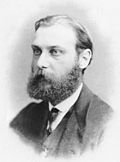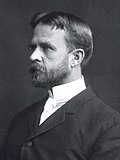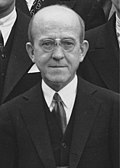Timeline Of Genetics Discoveries
From WikiLectures
| Year of discovery | Personality/Personalities | Discovery |
|---|---|---|
| 1865 | Johan Gregor Mendel | Laws of inheritance (Mendel's experiments, Laws of inheritance) |
| 1869 | Paul Langerhans | Discovered and described the islets of Langerhans in the pancreas (Diabetes mellitus) |
| 1869 | Friedrich Miescher | He isolated DNA for the first time ; isolated it in small quantities from white blood cells; not further analyzed ( DNA ) |
| 1879 | Walther Flemming | Chromosomes in mitosis (Chromosome, Mitosis) |
| 1892 | Dmitri Ivanowski (Дми́трий Ивано́вский) | The term virus (Viruses) |
| 1908 | Godfrey Harold Hardy a Wilhelm Weinberg | Basic law of population genetics (Hardy-Weinberg equation) |
| 1909 | Karl Landsteiner | Blood group system AB0 – classification of people into blood groups A, B, AB, 0; 1930 Nobel Prize (Heredity of blood group systems) |
| 1909 | Thomas Hunt Morgan | Linear arrangement of genes on chromosomes, linkage of genes, phase coupling and repulsion; 1933 Nobel Prize (Genetic linkage) |
| 1910 | Albert Kossel | Cytology - research on proteins and nucleic acids; 1910 Nobel Prize (Nucleic acid, proteins) |
| 1911 | Peyton Rous | Discovery of a virus with oncogenic potential - domestic chicken sarcomas; 1966 Nobel Prize (Viruses, Oncovirus) |
| 1920 | Frederick Banting a John J. R. Macleod | Isolation of an active substance from the pancreas for the treatment of diabetes; 1923 Nobel Prize (Multifactorial Inheritance, Autoimmune Diseases, Genetic Engineering) |
| since 1930 | George D. Snell | Discovery of genetic factors that determine the possibility of tissue transplantation, the histocompatibility complex (H-2) of the mouse; 1980 Nobel Prize (Major histocompatibility complex, Transplantation) |
| since 1931 | William Bateson, Reginald Crundall Punnett | Linkage of genes, crossing-over, recombination; (Genetic linkage) |
| 1937-45 | George Wells Beadle, Edward Lawrie Tatum | Biochemical and genetic studies on the Neurospora microorganism – determining the ability of genes to regulate certain chemical reactions; 1958 Nobel Prize (Cell signalling) |
| 1944 | Oswald Avery, Colin MacLeod, Maclyn McCarty | Basic genetic information is stored in DNA (Prokaryote, Transformation) |
| 1940-50 | Barbara McClintock | The genetic map of maize, the role of centromeres and telomeres and the subsequent discovery of genetic transposition – mobile DNA sequences (transpososomes); 1983 Nobel Prize (Transposomes, Centromere, Telomere) |
| 1940-60 | Peter Brian Medawar, Frank (Macfarlane) Burnet | Transplantation – discovery of acquired immunological tolerance; 1960 Nobel Prize (Transplantation, Immunological tolerance and possibilities of its induction) |
| 1950 and 1970-80 | Edward B. Lewis; Christiane Nusslein-Volhard a Eric F. Wieschaus | Developmental Genetics; first Drosophila melanogaster – discovery of the principle of co-linearity (localization of sets of genes on chromosomes is related to the arrangement of body segments). Furthermore, this principle is confirmed for all multicellular animals; 1995 Nobel Prize (Embryonic development, Drosophila melanogaster) |
| 1950-61 | Francois Jacob, André Lwoff, Jacques Monod | Control and regulation of the expression of enzymes of metabolic pathways by feedback with the DNA sequence (e.g. E. coli /lactose); 1965 Nobel Prize (Unicellular models, Prokaryote) |
| 1950-59 | Stanley Cohen, Rita Levi-Montalcini | Isolation of nerve growth factor (NGF), which led to the discovery of epidermal growth factor; 1986 Nobel Prize (Cell signalling, Proto-oncogenes, oncogenes) |
| 1953 | James D. Watson, Francis H. C. Crick, Maurice H. Frederics | Determination of DNA structure; 1962 Nobel Prize (DNA) |
| 1956 | Joe Hin Tjio a Albert Levan | Determining the exact number of chromosomes in human somatic cells (karyotype) |
| 1956 | Robert W. Holley, Har. G. Khorana, Marshall W. Nirenberg | Role of RNA in protein synthesis, genetic code and its role in protein biosynthesis; 1968 Nobel Prize (mRNA, Translation) |
| 1957 | Arthur Kornberg | While studying the bacterium Escherichia coli , he discovered DNA polymerase ( DNA ); Severo Ochoa and Arthur Kornberg for the discovery of the mechanism of RNA and DNA biosynthesis 1959 Nobel Prize |
| 1958 | Tuneko Okazaki, Reiji Okazaki | Semiconservative process of replication, Okazaki fragments (DNA) |
| 1958-69 | Earl W. Sutherland, Jr. | Isolation of the hitherto unknown cyclic adenosine monophosphate (cAMP), clarification of its role in the metabolism of some hormones; 1971 Nobel Prize (Cell signalling) |
| 1959 | Jérôme JL Marie Lejeune | Chromosomal basis of Down syndrome - trisomy of chromosome 21 (Down Syndrome) |
| 1960-65 | Baruj Benacerraf, Jean Dausset | Discovery of the HLA complex and characterization of the genes of the major histocompatibility complex (HHC) of humans and subsequently other vertebrates; 1980 Nobel Prize (Major Histocompatibility Complex,) |
| since 1960 | Alfred Goodman Gilman, Martin Rodbell | Discovery of G-proteins and elucidation of their role in cell signaling; 1994 Nobel Prize (Cell signalling) |
| since 1961 | Leonard Hayflick a P. Moorhead | They described a limitation in the number of cell cycles in fibroblasts cultured in vitro - the so-called replicative aging (senescence) (Replicative aging) |
| 1962 | Werner Aber, Daniel Nathans, Hamilton O. Smith | Discovery of restriction endonucleases; 1978 Nobel Prize (Restriction fragment length polymorphism) |
| 1970 | David Baltimore, Renato Dulbecco, Howard M. Temin | Oncovirology – interaction of retroviruses with the genetic material of the cell, reverse transcription; 1975 Nobel Prize (Oncogenetic viruses, Viral carcinogenesis) |
| 1970-71 | Leland Harrison Hartwell, Richard Timothy Hunt, Paul Maxime Nurse | While studying the cell cycle of yeast ( Saccharomyces cerevisiae ), genes regulating the cell cycle were discovered; discovery of homologous genes in humans (cyclins and cyclin-dependent protein kinases) (The Cell Cycle, Proto-oncogenes, oncogenes) |
| 1970-80 | Susumu Tonegawa | DNA analysis of B cells (experiments on mice), discovery of the genetic principle of antibody diversity; 1987 Nobel Prize (Genetic control of antibody production) |
| 1970-80 | John M. Bishop, Harold E. Varmus | Study of the relationship of retroviruses to the development of malignant tumors, discovery of the first human oncogene c-src; 1989 Nobel Prize (Oncovirus, Proto-oncogenes, oncogenes) |
| 1975 | Edwin Mellor Southern | He developed a DNA hybridization method in gel electrophoresis to identify a specific DNA sequence (DNA hybridizace, Southern blotting) |
| 1975 | John Foxton Ross Kerr | He first described apoptosis – the genetically programmed death of cells; The 2002 Nobel Prize - Sydney Brenner, H. Robert Horvitz, John E. Sulston - was awarded for the discoveries of genetic regulation of organ development and apoptosis (Embryonic development, Aging of the organism) |
| 1975-77 | Frederick Sanger, Walter Gilbert, Paul Berg | They developed DNA sequencing techniques; 1980 Nobel Prize ( DNA ; Sequencing ); Frederick Sanger already won one Nobel Prize in 1958 for determining the polypeptide chain of insulin (Genetics of "civilization" diseases) |
| 1976 | Harald zur Hausen | Discovery of the papillomavirus, which is the cause of cervical cancer; Nobel Prize 2008 (Viral carcinogenesis) |
| 1977 | Richard John Roberts, Phillip Allen Sharp | They independently discovered the division of genes of eukaryotic cells into sections (introns and exons) and the cutting of introns from mRNA (gene-splicing); 1993 Nobel Prize (Gene structure, Post-transcriptional Modifications) |
| 1982 | Stanley B. Prusiner | He formulated a theory about a new causative agent of infectious diseases of the nervous system; discovery of prions; 1997 Nobel Prize (Prions) |
| 1983 | Francoise Barré-Sinoussi, Luc Montagnier | Discovery of HIV (Human Immunodeficiency Virus); Nobel Prize 2008 (Imunodeficience, AIDS) |
| 1984 | Elizabeth Blackburn, Carol Whidney Greider, Jack William Szostak | Discovery of telomeres (protection of the ends of linear chromosomes) and the enzyme telomerase; Nobel Prize 2009 (Telomeres and telomerase) |
| 1985 | Kary Banks Mullis with colleagues | He developed the PCR (Polymerase Chain Reaction) method, which makes it possible to multiply a selected section of hereditary information from a single DNA molecule; Nobel Prize 1993 (DNA, Polymerase Chain Reaction) |
| 1988-2001 | Project HUGO | Human Genome Sequencing; The international consortium Human Genome Project and the American private company Celera Genomics - "rough" reading of the genome (DNA, Genetic mapping) |
| 1989 | Mario Renato Capecchi, Martin Evans, Oliver Smithies | Study of embryonic development – mouse embryonic stem cells, knockout mice; Nobel Prize 2007– (Stem cells, Knockout mouse, Mus musculus) |
| 1990 | Stephen F. Altshul, Gish W., David J. Lipmann, Miller W., Eugene Wilson Meyers | They created the BLAST (Basic Local Alignment Search Tool) algorithm for calculating sequence similarity and then searching for genes and proteins based on mutual homology ( in silico – computer models) |
| 1990 | William French Anderson | The first performed gene therapy on a 4-year-old child suffering from immunodeficiency ( SCID – Severe Combined Immunodeficiency); the treatment result was partial. 2001 Alan Fisher cured SCID (Imunodeficience) |
| 1996 | Dolly the sheep | First cloning of a mammal from a single body cell (Stem cells) |
| 1998 | Andrew Z. Fire, Craig C. Mello | Discovery of RNA interference – a system of controlling the activity of some (specific) genes; Nobel Prize 2006 (Transcription, RNA interference) |
Prominent figures in the history of genetics[edit | edit source]










